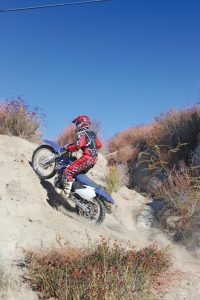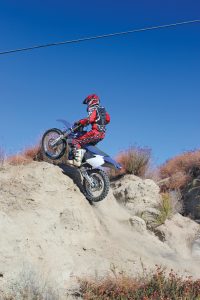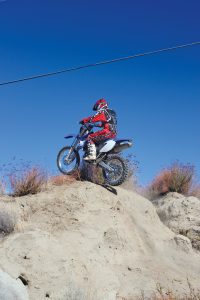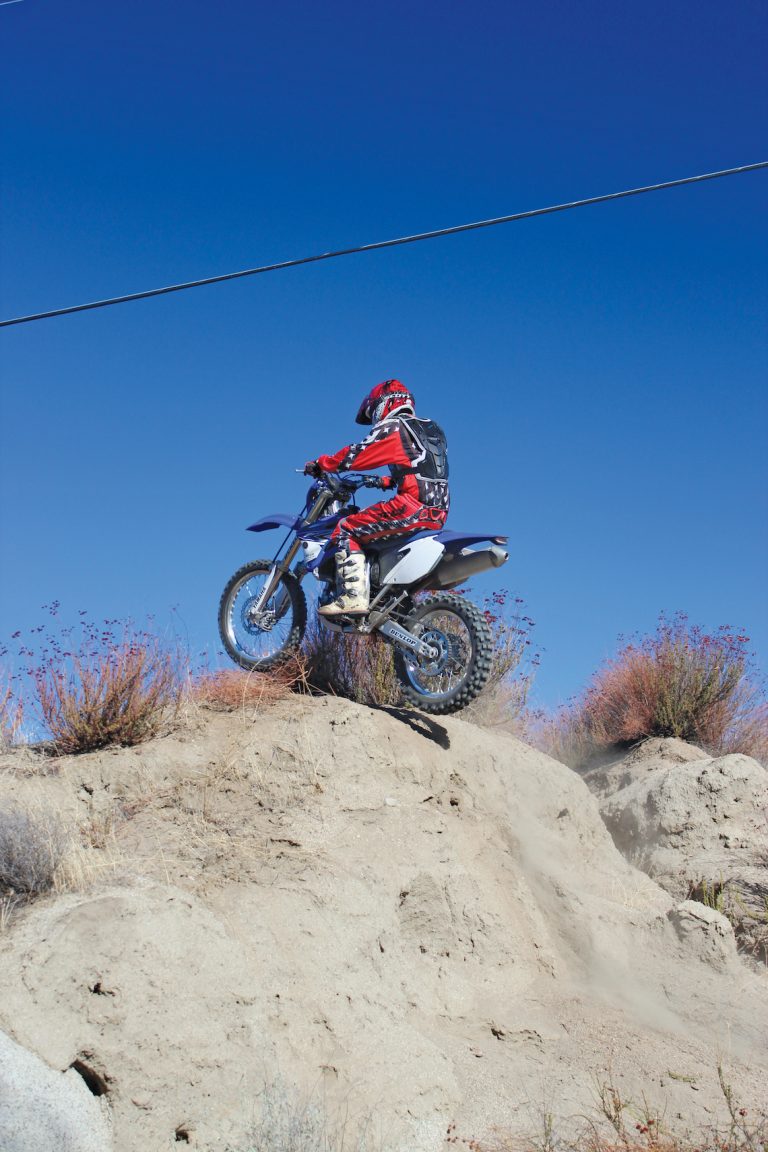TACKLE HILLCLIMBS
Technical hillclimbs require that you pick a good line and stick to it
Climbing hills is one of the most challenging, thrilling things one can do on a dirt bike. There are different kinds of hillclimbing challenges out there. We’ll focus on the basics first and then on the two most common technical climbs riders will encounter: long technical hillclimbs and short, low-traction hillclimbs.
Basic hillclimbs
To practice basic techniques, choose a fairly easy hill with few obstacles and fairly good traction. As with any hillclimb, take a good look at the hill ahead of time and choose what you feel is the easiest, smoothest line. Begin your climb by being back far enough from the base to get the most possible speed that you can safely hit at the start of the hill (this could be as high as third gear). You’ll find that momentum is your best friend in hillclimbing, and the more momentum you start out with at the bottom, the easier it will be in the last 25 percent of the hill where most people fail.
Hit the base of the hill in the attack position, carrying as much momentum as possible, and stay on the throttle on the way up. Then, as conditions dictate, you may have to quickly and smoothly shift into a lower gear if you hear the engine start to bog. At some point in nearly every hillclimb, you’ll have to shift your weight from the rear to the front to keep the front wheel down as it gets steeper and you get more traction. You can also feather the clutch to keep from wheelying over, as well as using throttle control. The main thing to avoid on a hillclimb is bogging the engine and losing momentum. Once that happens, it’s much more difficult to get going again. It’s okay to have a good amount of wheelspin on the way up if you’re still keeping your momentum moving up the hill.
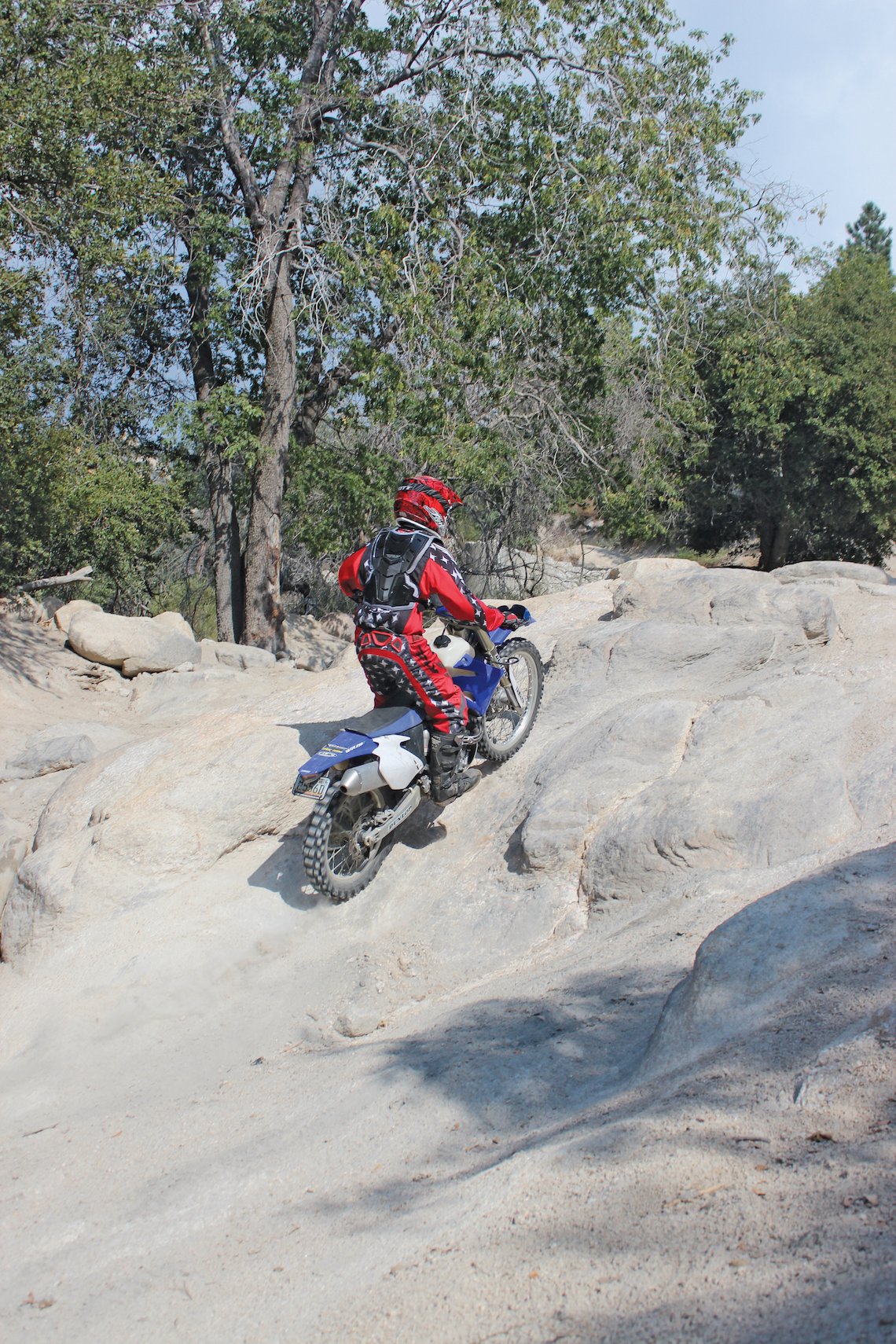
Long technical hillclimbs
To practice technical hillclimbs, locate a long technical uphill, all the better if it has multiple lines that are loose, turning, rutted, and bumpy, requiring that you pick and stick to a good line. Start in first and shift up as you accelerate. Remember, sometimes staying on line is more important than speed, but of course if the hill is long and loose, speed is an important ingredient. Make sure you stand up and ride a little bowlegged or you may fall victim to dreaded butt steer. As the hill becomes steeper and more technical you may need to shift down, but try to maintain some speed if you can. Keep leaning forward to keep the front end down, but you may need to move your weight rearward for traction and from side to side to keep the bike on the line you want.
Try not to wheelie too much. This could cause you to shut off the throttle to let the front wheel down to regain control, which could ruin your attempt. Try to keep your wheels in line when driving uphill. Too much throttle could get you sideways and either send you off-line or slow your momentum. If climbing while sitting, do not slide backward on the seat or your bike will wheelie too easily and send you out of control. Look ahead and try to build your speed in the traction zones so you can shut off the throttle or use the clutch and let momentum carry you over the loose patches. Cover the clutch with two fingers in case you need to slip it to keep the revs up or to keep the front wheel down.
Low-traction hillclimbs
To practice low-traction hillclimbs, start by locating a relatively short hill that gets increasingly steeper. Perhaps there’s a vertical step at the top, or the top is steep and the soil is loose. Imagine that it has no traction (due to vertical terrain, mud, loose soil, rocks, and so on), and keep in mind the golden rule of climbing up or over a slippery obstacle: Don’t try to get traction where there is none. Approach it in second gear (on most bikes) standing up. Accelerate before the hill, getting traction where the traction is, and use momentum instead of relying on traction to carry you through the no-traction zone. Once you know you will make it, using good judgment, shut off the throttle and time your deceleration so you crest the hill at low speed and without spinning the rear tire and leaving a trench. Remember to judge it correctly so you have the momentum for the rear tire to clear the top and then be ready to immediately pull in the clutch and use the brakes in case you must stop or make a tight right or left turn. As you climb over the top, make sure you squat low and absorb the bike to help maintain control. Once the rear tire clears the top you can get back on the throttle and ride away.
What is butt steer?
Sitting down over rough terrain often results in a dirt-bike riding phenomenon we call “butt steer,” which is when the rear tire hits a bump or rock and the jolt is transferred through the rider’s butt, then torso, and then up to the arms, affecting the steering in a negative way, usually off-line and grinding to a halt nowhere near the top. Standing up will help cure this problem by allowing your legs to absorb and spring with the jolts, giving you better control so you can stay on the best line to climb the hill.
The book
How to Ride Off-Road Motorcycles is written by Gary lePlante and Lee Parks and published by Motorbooks. It’s available now from www.ukmotorbooks.co.uk, amazon, and Grantham Book Services (01476 541080) priced £18.99
And when it all goes wrong…
Climbing hills is one thing, but getting back down safely after a failed attempt is another. This is a critical skill for riding off-road
- To simulate getting stuck on gentle slope, ride straight up it in first gear while sitting down and purposely stall your engine by stopping without pulling in the clutch (to prevent from rolling backward).
- Hit both brakes hard and try to get the bike stabilised as quickly as possible and dismount uphill, never put your foot down on the downhill side of the bike; if you do, you’ll greatly increase your chances of losing your balance and crashing downhill.
- Sometimes when you stop on a steep hill you won’t be able to keep the bike upright and to prevent it from sliding downhill you will have to lay the bike down, preferably on the left side (away from the throttle—to keep from damaging the throttle tube or filling it with abrasive dirt). Drag either end, usually the rear, with your right hand, while holding the handlebars with your left. The bike will then be perpendicular to the hill so you can lift it up again without it rolling down, staying on the uphill side.
- Lean the bike into your hip, turn the handlebars, release the clutch, and control the bike as you slowly back it down with the front brake.
- Walk back with the bike and “wiggle walk” (by turning the handlebars full left and full right repeatedly) the front wheel around until you’re pointing downhill.
- Get ready to mount up and place your foot on the downhill foot peg.
- Avoid losing your balance at this critical time. Pull in the clutch and release the brakes and begin rolling downhill.
- Remember: Don’t be in a hurry, take your time!
Quick recap
Long, loose hills
- On long, loose hills it’s important to start out with good speed at the bottom and try to maintain it as long as possible.
- Shift down as you slow down and shift your weight forward to keep your bike from wheelying or shift your weight rearward slightly for more traction.
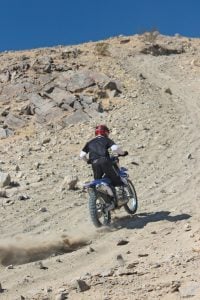

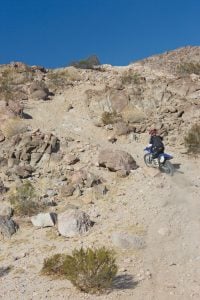
Short Climbs
- To climb a short, steep hill it’s important to be very aggressive on your approach by leaning back and accelerating hard to get all your speed and traction before the steepest part where there’s little or no traction.
- At this point you’re in the attack position and staying on the gas.
- Note how the front and rear suspension systems are taxed as you hit the face of the hill. This helps keep the rear wheel driving, too.
- As your bike climbs almost vertically, lean forward and bend your arms and knees to stay low on the bike. At this point you’ve got plenty of momentum to make it and can let off the gas.
- As you crest stand up and ride away.
Technical hills
- To climb a long technical hill it’s important to pick and stick to the smoothest, highest traction line possible and attack it with plenty of speed, especially at the bottom.
- On hills like this there are plenty of rocks and ruts that will turn you if you hit them, so be sure to move your body freely from side to side to keep the bike going where you want it to go.
